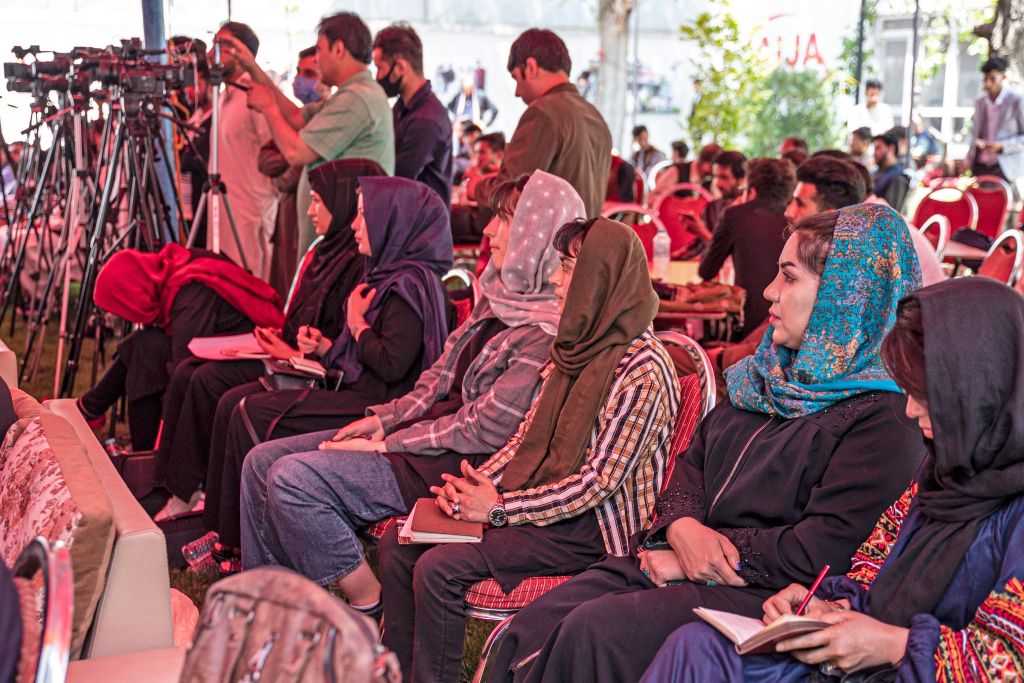As we prepare to celebrate World Press Freedom Day, it’s worth reflecting on how it’s become a rare privilege to spot a female face on Afghan television — whether they wear a face covering or not. On some channels, voices of women are broadcast, but their faces are nowhere to be seen.
Now, even these brief glimpses of women on Afghan TV might disappear. Near the end of February, Sheikh Mohammad Khalid, the Taliban’s Minister for the Propagation of Virtue and Prevention of Vice, gathered owners of media companies for a meeting in Kabul and issued a warning: women working in media needed to start covering their entire faces, leaving only their eyes visible; otherwise, the Taliban would ban women from working in the industry.
This was the latest salvo in a long-running fight over representation of women in Afghan media. Female anchors had already been forced to cover their faces when they went on air since May 2022, when the Taliban issued a decree requiring women to cover their faces in public. And in some parts of Afghanistan, local officials have already been imposing even harsher restrictions, such as banning the broadcast of women’s voices on radio stations and forbidding women from calling in as listeners.
In Khost province, in the south of the country, the police chief described the act of women listeners calling a radio station as engaging in “illicit relations”. In a statement directed at the media industry, Khost police chief Abdul Rasheed Omari said: “In this province, some radio stations are promoting moral corruption; a good example of that is the broadcast of educational programs on radios, in which more girls participate; in these programs, in working and non-working time, the girls contact the officials of the radio stations and engage in illicit relations.”
The police chief is not in charge of imposing restrictions on media outlets. Yet his order was implemented immediately, as journalists in the province have confirmed to Zan Times.
Then, on April 24, the Afghanistan Journalists Center (AFJC) reported that three radio journalists in Khost had been arrested for broadcasting background music and speaking on air with female listeners. The center said local officials of the ministry of virtue and vice confirmed that “media were advised multiple times not to include background music in programs or to make phone calls in entertainment programs with women as it is forbidden”, and said the journalists faced being sentenced to time in prison.
All told, the Taliban have put out more than 50 decrees aiming at a total erasure of women from Afghan society.
The Khost police chief’s letter specifically disapproves of “educational programs” — these are probably the last remaining option for many girls seeking any kind of education after the Taliban banned girls from studying beyond sixth grade.
And the restrictions imposed on media organizations don’t end with banning women’s faces or voices. They also include censorship of content related to women’s issues or any content the Taliban deem is critical of their regime, according to several journalists working inside the country.
One broadcast journalist based in Kabul told us that his colleagues have been interrogated by Taliban officials several times for covering issues such as their ban on girls’ education and women’s beauty salons, and even for stories about senior citizens not receiving their pensions.
Another journalist in Herat province, in the west of the country, said he had been interrogated three times because of his work.
“I don’t work on the news desk, and I have not made content critical of the Taliban. But I have been summoned to the Taliban’s intelligence office three times because I have produced content about issues such as urban cleanliness and traffic congestion,” said the journalist, who we are not naming to protect them from retaliation from the Taliban. “They say that I should not produce content that shows the Taliban in a negative light.”
He said the Taliban described him as a “spy” during the interrogation.
Several journalists also told us they are now asked to send their content to the Taliban before broadcast or publishing. Some even said their newsrooms had been forced to hire Taliban officials to “monitor” their content, an action that led to many women journalists leaving their jobs because they no longer felt safe coming to work — worried that simply being seen speaking with a male colleague could land them in trouble.
“When I joined [my TV station] in November 2021, there were 20 female reporters — now, only three remain,” a Kabul-based female journalist shared at an online event to mark Women’s Day this year.
This means that at a time when women in the country are especially vulnerable, there are hardly any women reporters left to cover the issues that affect them most.
There is certainly a lot more to cover on this topic. If you are interested in learning more, please visit our website zantimes.com: we will be publishing a larger story about the Taliban’s censorship of the media on May 3.


 Zahra Nader
Zahra Nader
